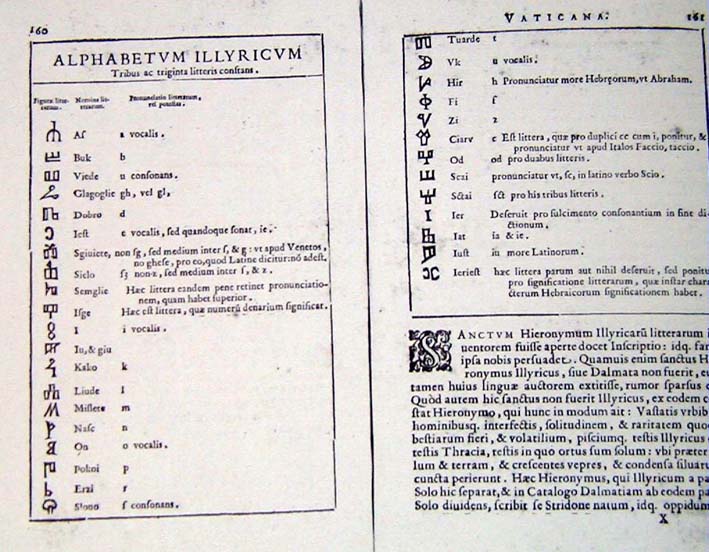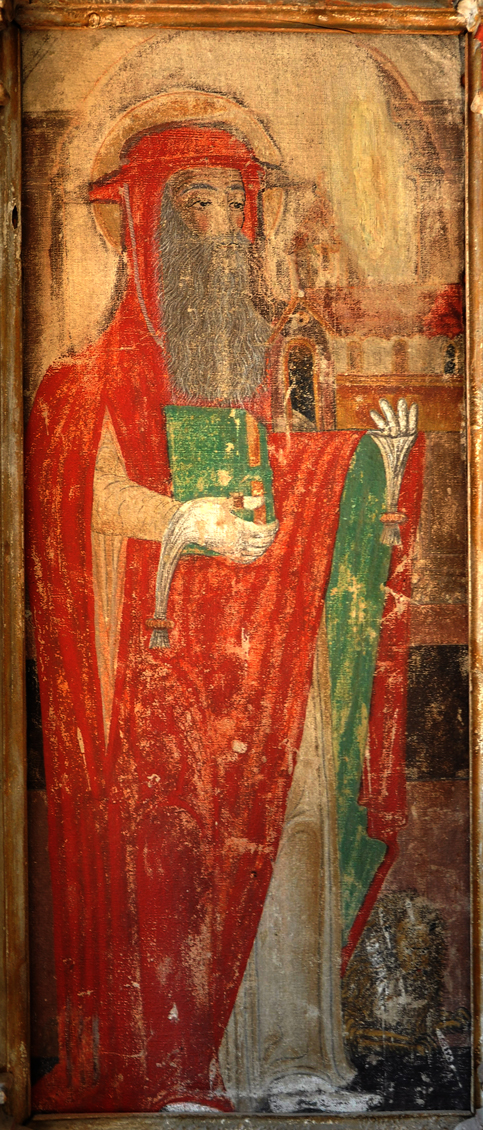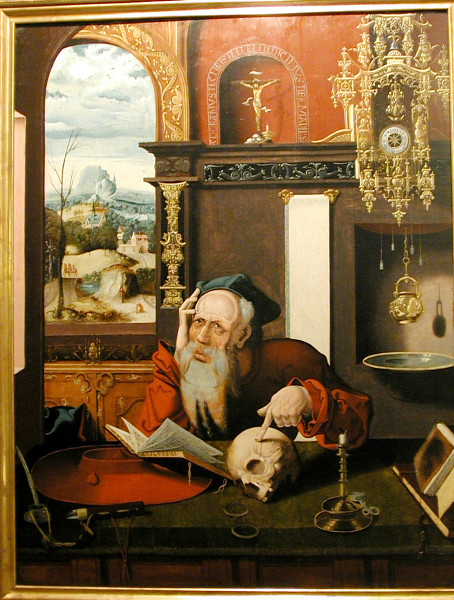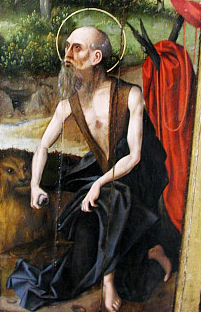In Rome he had already prepared a translation of the New Testament from Greek into Latin; he continued this work in Bethlehem, translating most of the Old Testament into Latin from Hebrew. Together, these translations became known as the Vulgate, the official Bible of the Roman church. He also produced a vast collection of commentaries, treatises, and polemics that had a great influence on Christian theology (Butler III, 686-693).
The oldest known image of St. Jerome pictures his voyage to Jerusalem and his activities there. Later medieval and Renaissance images will derive their iconography from the Golden Legend or its sources.
JEROME'S VISIONS
The first episode in the Legend's life of St. Jerome recounts a vision of his in which he was scourged in Heaven for retaining his books of classical literature. Upon awakening, he saw the marks of the scourge on his shoulders. Thus some images feature his beaten back (example) or show angels whipping him (example).In another vision, not included in the Golden Legend but frequently represented in 17th-century images, Jerome hears the angel on a cloud trumpeting the Last Judgment (example), or just a trumpet issuing from a cloud (example). The ultimate textual source for this iconographic type is an admonition in the Regula Monachorum published in 1429 but ascribed to Jerome: Semper tuba illa terribilis vestris perstrepat auribus: Surgite mortui, venite ad judicium (Migne XXX, 387: "Always the terrible trumpet sounds in your ears, saying 'Arise, ye dead, and come to your judgment!'"). Some 15th-century portraits had Jerome holding a book with parts of this quotation presented as if it was Jerome who was being admonished. Later portraits made the leap to showing the angels trumpeting to the saint (Worcester Art Museum, 5-6).
DRESSED AS A CARDINAL
In the next episode the Legend reports, incorrectly, that St. Jerome was "ordained a cardinal-priest in Rome" (Ryan II, 212). Because of this report, he is often dressed portrayed as a cardinal with a red cape and a red flat-top cardinal's hat (example) though these are sometimes set aside as a token of humility and of his having left Rome and its temptations behind, as in the third image at right. In fact, the title of Cardinal did not exist until some decades after Jerome's death; the cardinal's garb refers rather to the saint's service as an advisor to Pope Damasus I.1BEATING HIS BREAST
The next episode in the Legend tells of the four years St. Jerome spent in the desert, where he prayed and fasted to still his sexual desires.2 This part of his life is popular in the art, where he is commonly shown holding a stone used for beating his bare breast (example). One such image shows him in a ruined apse with a crudely mounted miniature church bell. The "scorpions and wild beasts" the Legend says were his company are represented at least once, in a relief in Trogir, Croatia.In paintings of this type Jerome is often shown contemplating a crucifix while beating his breast (example). In an extension of this type of image, he can also be shown standing at the Crucifixion itself, with bare breast and stone in hand (example). His clothing will be ragged and/or skimpy. Some 16th-century portraits will make some part of his garb red as a reminder of his supposed status as a cardinal (example).
WORKING IN HIS STUDY
Next in the Legend, we read of St. Jerome's long sojourn in Bethlehem, where he studied scripture and completed his translation of the Bible into Latin. This part of the saint's life is represented in the many images that show him in his study with his books. The second image at right exemplifies one subtype, where the saint's eyes engage the viewers as he points to a skull. Other examples of this subtype place the words cogita mori ("think of your death") somewhere in the image.The image at right also typifies the objects commonly included in Jerome's study: a crucifix, red garments and hat, a book, writing implements, a candle, and (beginning in the 15th century) eyeglasses. The candle and spectacles refer a remark in one of Jerome's commentaries:
My eyes are growing dim with age and to some extent I share the suffering of the saintly Isaac: I am quite unable to go through the Hebrew books with such light as I have at night, for even in the full light of day they are hidden from my eyes owing to the smallness of the letters. In fact, it is only the voice of the brethren which enables me to master the commentaries of Greek writersIn some images one or two angels have visited the study to help Jerome with his commentaries (example). In some cases where he is shown writing a dove will be seen whispering in his ear.4
— Preface to book VII of the Commentary on Ezechiel.3
WITH SAINTS PAULA AND EUSTOCHIUM
Another aspect of St. Jerome's years in Bethlehem was his promotion of the dedicated life for Christian virgins and his correspondence with a number of these, especially Saints Paula and Eustochium, to whom many of his letters were addressed. A painting by Francisco de Zurbarán shows him in conversation with these two women. The Legend then turns to the story of St. Jerome's pulling a thorn from a lion's paw (as in Riemenschneider's sculpture). In gratitude the lion is said to have become a sort of lay brother in Jerome's monastery, doing chores and guarding the monastic donkey. The lion is as common an attribute of the saint as his red cardinal's garb, as in the first image at right and most of those referred to above.WITH A MAQUETTE OF A CHURCH
In many images in Dalmatia, Istria, and the Veneto Jerome holds a maquette of a church (example). The only example I have found outside this region is a statue in Canterbury Cathedral. A maquette usually denotes a specific church or abbey founded by the pictured saint, but in this case it most likely functions to claim for Jerome a foundational role in Croatian Christianity. Because he was born in Dalmatia many Croatians have considered him one of their own, and during the Middle Ages they credited him with composing their Church Slavonic liturgy and the Glagolitic script in which it was written.5 Cultural interchange would explain the images with maquette in Venice, which ruled parts of Dalmatia and Istria at various times. A Glagolitic press was active in Venice by 1493 (Magocsi, 56).
OTHER ATTRIBUTES
St. Jerome is often pictured reading from an open book, referring to his scholarly inquiries (example). Less often, he will be portrayed with a quill pen (example) or prayer beads (example).RECEIVING COMMUNION FOR THE LAST TIME
Late medieval images of Saint Jerome's death often show him kneeling to receive the Eucharistic host for the last time (example). This image type traces to a passage in a letter on the subject of Jerome's death that was composed in the late 13th century and circulated widely in the 14th and beyond. It purported to be by one of the saint's 5th-century companions.6 The passage in question is attuned to the 13th century's embrace of Transubstantiation — that is, the belief that in the Mass the bread becomes the body of Christ even while retaining its outward appearance.7 Near death, Jerome has been lying prostrate when the priest arrives with the host, which he addresses as being indistinguishable from Christ himself:When the priest came to him the glorious man raised himself with the help of some of us and knelt. Weeping and beating his breast, he said, "Are you my God and my Lord, who suffered for me, or are you another? Surely you are he who alone is with God before all times and begotten of God the Father without beginning in eternal and inscrutable generation, who with the Father and the Holy Spirit is one God — and who, remaining entirely yourself, hid within the body of a girl and made yourself a man like me. Truly you are God and man.…"8
Prepared in 2014 by Richard Stracke, Emeritus Professor of English, Augusta University.
HOME PAGE

St. Jerome dressed as a cardinal and carrying a book and a maquette of a church. The maquette is typical of his images in the Dalmatian and Istrian areas of Croatia. (See the description page.)

St. Jerome in his study (See the description page)

As a penitent in the desert (See the complete image at the description page)
ATTRIBUTES
- Red cardinal's hat and cape
- A lion
- A stone in his hand
- A maquette of a church
MORE IMAGES
- 15th century: The predella of an altarpiece in Salamanca pictures St. Jerome as a cardinal with pen, book, and lion.
- Circa 15th century: Altar frontal in Split, Croatia.
- 15th or 16th century: Statue of Jerome with the maquette in a monastery in Zadar, Croatia.
- 1426: Jerome is paired with St. Augustine in these panels of the Pisa Polyptych.
- Second half of the 15th century: Lazzaro Bastiani's Predella of St. Jerome
- 1460-90: The Master of Liesborn's Saints Ambrose, Exuperius, and Jerome.
- 1474: Among the saints in Vivarini's St. Mark Enthroned in the "Frari" church in Venice is this portrait of St. Jerome holding a maquette of a church. He also holds a similar maquette in this statue in the same church.
- 1476-80: Statue: Preparing to beat his breast with a red stone.
- 16th century: Statue in a monastery in Sobrado, Spain.
- 1505: In Bellini's Madonna and Child with Saints
- 1507: Santa Croce's Madonna and Child with Zacharias and St. Jerome.
- 1512-18: Antoniazzo Romano, St. Jerome Healing a Lion.
- 1513-14: With SS. Andrew and John the Evangelist in the Costabili Polyptych
- 1540-43: Bonifacio Veronese, Sacra Conversazione with Tobias and the Angel.
- 1566: Veronese, St. Jerome as a Hermit.
- First half of 17th century: Matteo Ponzone, St. George with Saints Jerome and Tryphon
- 1610-14: El Greco's portrait.
- 1656: Van Slingelandt, St. Jerome at Prayer in a Cave.
- 1750: In the margin of a Mexican nun's badge of the Annunciation.
- Undated: In a panel in the Santa Sabina Altarpiece in Venice, Italy.
DATES
- Feast day: September 30
- Born ca. 342, died 420 (Butler, III, 686); but medieval sources always say he died at age 90 or later.
BIOGRAPHY
NOTES
1 Catholic Encyclopedia, s.v. "Cardinal." Molanus, III, 360.
2 The passage in the Legend closely follows paragraph 7 of Letter 22, to Eustochium, in Schaff, series 2, vol. 6: "Now, although in my fear of hell I had consigned myself to this prison, where I had no companions but scorpions and wild beasts, I often found myself amid bevies of girls. My face was pale and my frame chilled with fasting; yet my mind was burning with desire, and the fires of lust kept bubbling up before me when my flesh was as good as dead.… I remember how I often cried aloud all night till the break of day and ceased not from beating my breast till tranquillity returned at the chiding of the Lord."
3 Ibid.
4 An example from MS. Cambridge Corpus Christi College, 389, 1v is published in Rushforth, 43.
5 I thank Ms. Antoniya Letilovic for suggesting this inquiry into St. Jerome's place in Croatian historical memory. Many scholars question the facticity behind it, as the saint was born well before the migration of the Slavs into Dalmatia. For the historical development of Croatia's attachment to Jerome, see Verkholantsev, 42-48.
6 pseudoEusebius, chapters 45-52.
The letter is described in an essay on the Les Enluminures website. The purported author, Eusebius of Cremona, was a monk in St. Jerome's monastery and succeeded him as abbot.
7 Transubstantiation was defined as Catholic doctrine in 1215 by the Fourth Lateran Council. See the Catholic Encyclopedia, s.v. "Fourth Lateran Council." The 13th century saw extensive struggles between orthodox churchmen and Cathar "heretics," whose dualist version of Christianity denied the Eucharist and all other sacraments.
8 Pseudo-Eusebius, chapter 46 (my translation).